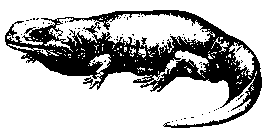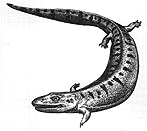
drawing by Mike Coates
| Mississippian Epoch | ||
| Paleozoic: Carboniferous Period |
Viséan Age |
| Tournaisian | Late Devonian | Mississippian | ||
| Serpukhovian | Pennsylvanian | Timescale |
Paleozoic Era |
|
The Viséan is an age in the ICS geologic timescale or a stage in the stratigraphic column. It is the second stage of the Mississippian, the lower subsystem of the Carboniferous. The Visean lasted from 345.3 ± 2.1 to 328.3 ± 1.6 Ma. It follows the Tournaisian age/stage and is followed by the Serpukhovian age/stage. This period, representing the later Early Carboniferous was a time of great innovation on land, with a great radiation of stem tetrapods and the first proto-amniotes.
Typical Carboniferous tetrapods appear for the first time.
| approx time | Nor t h |
A m e r
|
i c a | Western Europe | ||
| Location (present geography) |
Age | Iowa | West Virginia | Nova Scotia | Scotland Midland Valley |
|
| Brigantian | 334 336 |
St Louis Formation | Bickett Shale Bluefield formation |
East Kirkton | ||
| Asbian | 338 | |||||
| Viséan | Holkerian | 340 342 |
Wardie Shales | |||
| Arundian | 344 | |||||
| Chadian | 346 348 |
The climate of the Visean was similar to the Tournaisian at the beginning of the age but became increasingly warmer as it progressed. This is evidenced by migration patterns of marine invertibrates and land plants towards the polar regions. (Raymond 1985, 1990. Kelley and Raymond 1991).
The Visean forests were similar to the Tournaisian, however they consisted of different species and were more diverse and adapted to different habitats. Unlike modern plant groups where different species live in diverse habitats, those of the Visean were much more specific and preferred certain habitats, meaning the plant groups that inhabited wetlands will have no species that inhabit uplands and vice versa. Vegetation includes the lycopsid tree Archaeosigillaria, sphenopsids like Archaeocalamites/Calamites and Sphenophyllum, filicalean ferns, and small pteridosperms such as Heterangium.
MAK020624, Yogi121212

Phillipsia sp.
Class Trilobita
Order Ptychopariida
Suborder: Illaenina
Superfamily: Proetacea
Family: Phillipsiidae
Warsaw Formation
Middle Mississippian
Sunset Hills, Missouri
In the Visean age the early tetrapods had radiated into at least three main branches. Recognizable basal-group tetrapods are representative of the temnospondyls (Balanerpeton) lepospondyls and anthracosaurs (Silvanerpeton, Eoherpeton), which were the relatives and ancestors of the Amniota. Aistopods snake like lepospondyl amphibians appeared in the Visean (e.g. Lethiscus) as well as Adelogyrinids similar to Aistopods except they retained a shoulder girdle. Despite their very early date they were aklready highly specilaised animals. The first possible amniotes or stem amniotes appeared, such as Casineria, resembling small lizards that evolved from amphibian reptiliomorphs. Alongside these more advanced forms were a wide range of stem tetrapods (Crassigyrinus, Loxomma, Eucritta, etc). Recently "Gondwanan" tetrapods of middle Visean age were discovered in Australia (Thulborn 1996). The latest Visean East Kirkton quarry near Bathgate in Midlothian, Scotland is a virtual snapshot of late Visean life made up of tetrapods, scorpions, millipedes, eurypterids and a wide variety of plants.
Yogi121212, MAK120102

Lethiscus stocki
Class: Tetrapoda
Subclass "Lepospondyli" (polyphyletic?)
Order: Aistopoda
Family: Lethisciidae
Holkerian Stage
This small eel-like amphibian is one of the earliest known non-Devonian tetrapods. The body is already very specialized, with no trace of limbs or limb girdles

 |
drawing by Mike Coates |
Class: Tetrapoda
Order: Temnospondyli
Superfamily: incertae sedis
Family: Dendrerpetontidae
Brigantian Age
a genus of temnospondyl found at East Kirkton (early Serpukhovian) and elsewhere
 |
drawing by Mike Coates |
Depending on your preferred chronology, the famous East Kirkton site is either late Visean or Early Serpukhovian . We have followed Carroll 2009 p.63 in giving the date as late Brigantian of the latest Visean
page by M. Alan Kazlev 2002
page uploaded 24 June 2002
checked ATW030922, edited RFVS121030
(original uploaded on Kheper Site 1 June 1998)
this material (when it is up) may be freely used for non-commercial purposes